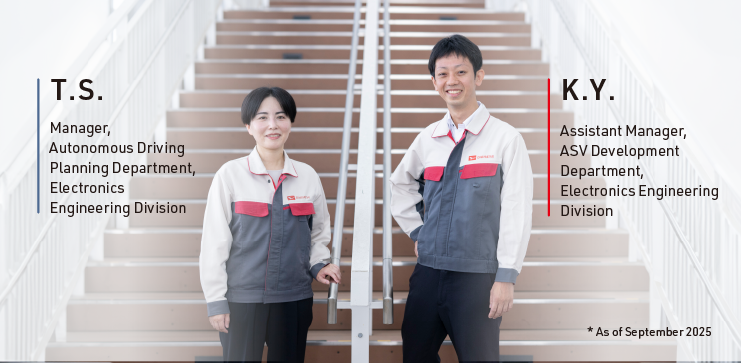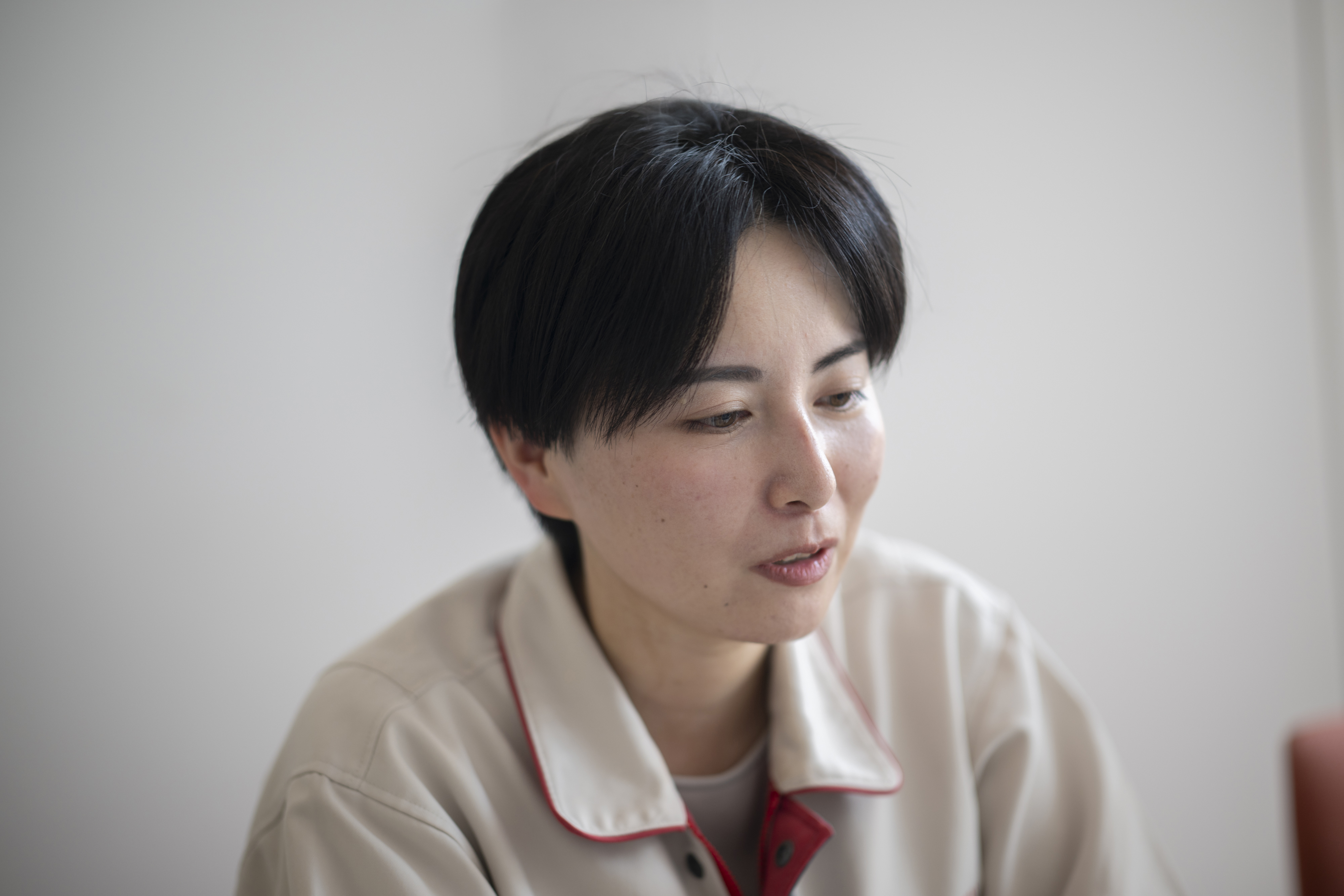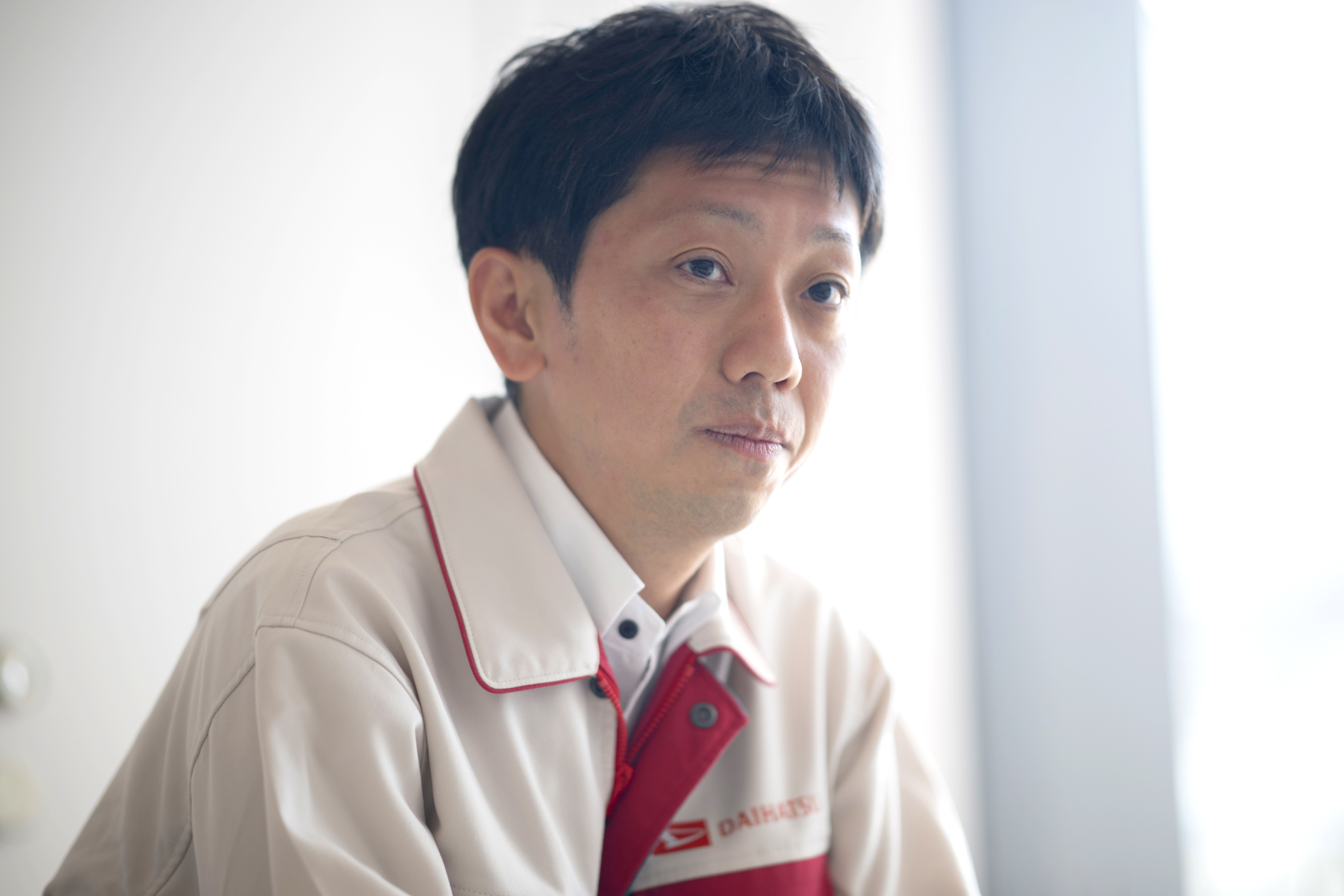Technology & MONODUKURI

Cultivating Technology from the Customer Perspective
and Providing Advanced Technologies for Everyone
The Forefront of Smart Assist and Autonomous Driving
I currently belong to the ASV Development Department of the Software Development Division, where I primarily work on the development of Smart Assist, and specifically collision-avoidance support braking. From design to testing and model-specific deployment, I help ensure brakes continue to function properly in the dangerous situations where they are needed most.
I was originally in the ASV Development Department that K.Y. is in, but now I work in the Autonomous Driving Planning Department on the advanced development of the next generation of Smart Assist and autonomous driving technology. In our work, we are always thinking about what features and functions customers need in their daily lives.
Technology Based on How Customers Use Our Products
Collision-avoidance support brakes help to minimize damage in the event that a customer finds themselves in emergency circumstances. There is more to this than merely applying the brakes. We need to consider under what circumstances the customer might apply the brakes, from that customer’s perspective. The development process takes a variety of driving scenarios into account, obviously including different times of day and night, weather, and road conditions, as well as roads in both Japan and overseas. For example, the typical distance between cars is quite small in Indonesia compared to Japan, and driving there requires frequent, quick turns and quick braking. As a result, adding the same features as are typical in Japan can seem meddlesome and overbearing to Indonesian customers. That is why we actually go to each market to properly tune our products to the local culture and driving habits. These adjustments are what lead to functions and features that are truly useful.

T.S:
The Autonomous Driving Planning Department is also highly mindful of “Daihatsu’s unique ease of use.”Rather than drivers who spend most of their time zooming down the highway, we focus on mini-vehicle users who drive down local roads on a daily basis and what features and functions they truly need. Even then, we do not just add advanced technologies, but instead aim to have our users think, “This would be convenient to have” or “This is just right.” To find the right inspiration, we head to various exhibitions and listen to research presentations on the driving habits of senior citizens. We also check on competitor trends and legal developments in other countries, continuously imagining what features and functions our customers might need in the future.
Lots of Value in a Small Sensor
In order to achieve my vision of the Daihatsu New Global Architecture (DNGA) philosophy—“compact, low cost, high performance,” multiple Smart Assist functions are controlled with a single stereo camera. The camera is connected to the front glass of the vehicle, and that one camera is designed to recognize pedestrians, control the brakes, and maintain lane position, among other functions. Daihatsu’s real expertise comes into play with respect to the question of how to most efficiently pack the necessary features into limited vehicle space. That requires a structure in which multiple components work together across categories, including the camera, brakes, and engine control unit (ECU).
Developing mechanisms like Smart Assist that control multiple features and functions with a single component truly requires collaboration across multiple organizations. Although different people are assigned to different features and functions, there is always someone whose job is to see the bigger picture and make adjustments, working closely with all of the teams during the development process. We regularly share information across departments, so teams can act with an understanding of what other departments are doing. Although we are few in number, we are highly mobile. It is very important for us to stay in close contact for day-today communication and to be adaptable, and I think that capability is one of our strengths.
Results and Endeavors Rooted in the Customer Perspective

K.Y:
One development project that left an impression on me was the sudden acceleration suppression system. This project was launched with the aim of decreasing the number of accidents caused by elderly drivers accidentally pressing the gas pedal instead of the brake. In designing this feature, it was extremely difficult to distinguish between times when the driver really wants to accelerate and times when they accidentally pressed the wrong pedal. For example, if the light turns green and the driver decides to accelerate, we want to enable that, and if they accidentally slam the gas pedal in a parking lot, then we want to suppress that. We attempted to devise ingenious ways to make those determinations, looking at all of the driver’s operations as a whole including how the gas pedal was pressed, how the gearshift was used, and how the brakes were used. Whenever a customer driving a Smart Assist-enabled vehicle tells us that it helped prevent an accident, I am really overjoyed. These moments make me sincerely glad to do this job, because I feel that my work was truly useful to someone.
During development of the preceding vehicle departure reporting function, I once enabled notification timing to be adjusted to three different levels. Initially, some feedback was that the function was too slow to respond, so I made improvements to suit the customers’intuition. Later, I was also involved in the development of the accidental reverse start suppression system, which was a big new experience to me because it was my first time using sonar-based controls and working on assembly in the plant. I really knew almost nothing about sonar at that point, so I had to start from scratch and figure out how to use it to achieve precise control, as well as how assembly should be done at the plant through several rounds of discussion with frontline personnel. Of course, no matter how carefully we design a feature, customers will sometimes use the product in an unexpected way that makes us realize we had never considered that possibility. We properly process that feedback and those failures, putting them to use in future product development. That process is an important part of our work.
Safe, Secure Products Customers Are Glad They Bought
Moving forward, I hope to continue safety-focused feature development that allows customers to ride in peace of mind. We will continue delivering value from the frontlines, never forgetting the customer perspective.
T.S:
I want to deliver to customers, in a timely manner, a product with features and functions they are happy to have and glad they bought.